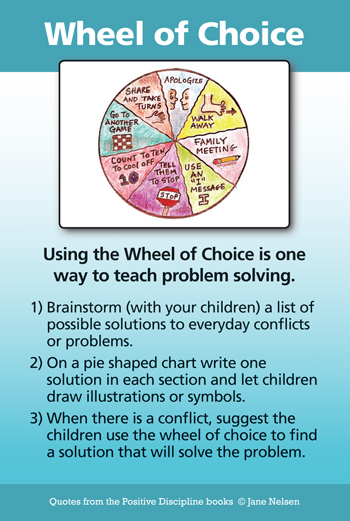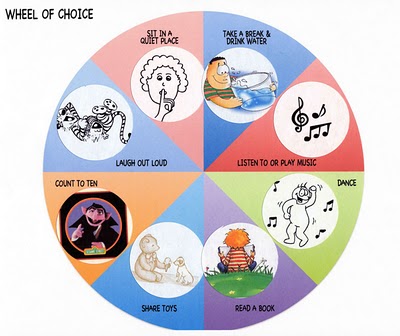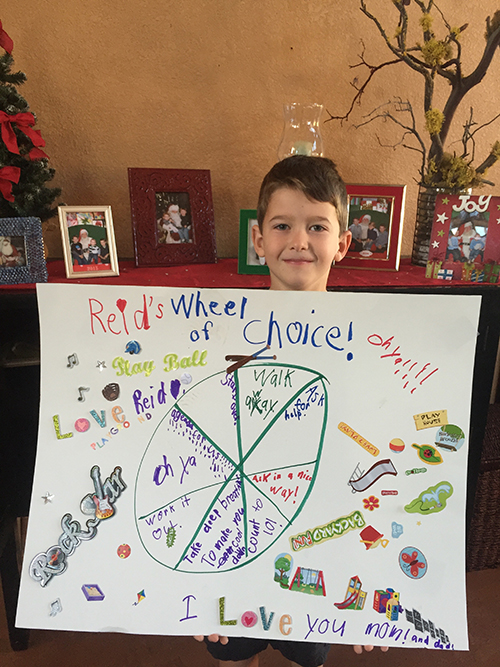Focusing on solutions is a primary theme of Positive Discipline, and kids are great at focusing on solutions when they are taught the skills and are allowed to practice them.
The wheel of choice provides a fun and exciting way to involve kids in learning and practicing problem-solving skills, especially when they are involved in creating it.
Make sure your child takes the primary lead in creating his or her wheel of choice. The less you do, the better. Your child can be creative and decide if he or she would like to draw pictures or symbols to represent solutions, or to find pictures on the Internet. Then let your child choose (within reason) where to hang his or her wheel of choice.
Older kids may not want to create a wheel, but could benefit from brainstorming ideas for focusing on solutions and writing them down on an easily accessible list. It is helpful when you have other options for finding solutions, such as family meetings. Then you can offer a choice: “What would help you the most right now—your wheel of choice or putting this problem on the family meeting agenda?”
Helping your child create a wheel of choice increases his or her sense of capability and self-regulation. From Mary’s story you will gain a sense of why it is best to have your kids make their own wheel of choice from scratch instead of using a template.
Success Story
The following Wheel of Choice was created by 3-year-old Jake with the help of his mom, Laura Beth. Jake chose the clip art he wanted to represent some choices. His Mom, shared the following success story.
Jake used his Wheel of Choice today. Jake and his sister (17 months old) were sitting on the sofa sharing a book. His sister, took the book and Jake immediately flipped his lid. He yelled at her, grabbed the book, made her cry. She grabbed it back and I slowly walked in. I asked Jake if he’d like to use his Wheel Of Choice to help—and he actually said YES! He chose to “share his toys.” He got his sister her own book that was more appropriate for her and she gladly gave him his book back. They sat there for a while and then traded!
Success Story
by Mary Tamborski, co-author of Positive Discipline Parenting Tools
It was such fun creating a wheel of choice with my son Reid when he was 7 years old. We purchased a few supplies in advance: poster board, stickers, scented markers, scissors, and colored paper. None of these materials are required, but I knew it would make it more fun.
It turned out to be even more of an advantage than I thought because his 3-year-old brother, Parker, wanted to be involved too. He had fun making his own wheel of choice (even though he didn’t really under- stand it). This was a great distraction for Reid’s little brother, who felt like he was involved in the process.
I started by asking Reid, “What are some of the things you do or can do when you are having a challenge?”
I was really impressed with how easy it was for Reid to come up with so many solutions. He had already been using many of these skills, so he created his list very quickly.
- Walk away or go to a different room.
- Take deep breaths.
- Put it on the family meeting agenda.
- Use a different tone.
- Ask Mom or Dad for help.
- Count to ten to cool off.
- Hit the “reset button” and try again.
He had fun writing them all on his pie graph. The scented pens added to his enthusiasm. He wanted to “practice” writing them on a piece of scratch paper before he officially drew them on his poster board.
I loved how he handled it when he misspelled a word or when his circle wasn’t even. He just crossed out the word and rewrote it. I was tempted to give my two cents and step in to fix it for him, but I remembered how important it was for him to do it by himself. I could see the pride in his grin and his little happy dance movement in his chair. I was relieved when Reid patiently allowed his little brother to be involved by adding stickers to his finished project.
Reid was so proud when he held up his wheel of choice. Even Parker was proud. They were both posing for a photo, and Reid even wanted me to take a video as he described it.
About two hours later he had his first challenge: his older brother, Greyson, was saying, “Reid smells like a fart.” Then he started mimicking everything Reid said.
Reid came to me and said, “Greyson keeps bugging me.”
I said, “You’re having a challenging moment. Would it help you to go to your wheel of choice to choose something you could do?”
He went to his wheel of choice, looked at it, and did his own little process of elimination. He said, “I’ve already walked away and he keeps following me.
I’m asking you for help.”
I asked, “What else could you try?”
Reid started taking deep breaths. Then he said, “I’m going to try asking him in a calm voice to please stop, and lie on the bed while you read us a book.”
It worked!
Before I could even fully process this magical moment, all three boys were lying next to me while we read a book.
One of the most valuable lessons I learned was that he had the tools and skills to solve his problems on his own. Knowing that he had his wheel of choice reminded me to not get involved in solving the problem. After all, getting me involved wasn’t one of his “solutions.” (Yes, asking me for help was one of his solutions, and I used my judgment to know he could find something that didn’t involve me. If he had been in physical danger I would have helped.)
Click Here to view the Wheel of Choice from a program created by Lynn Lott and Jane Nelsen (illustrations by Paula Gray).
Click Here to get a more complete description and to order your own Wheel of Choice: A Problem Solving Program. It includes 14 lessons to teach the skills for using the Wheel of Choice.




No Comments yet!